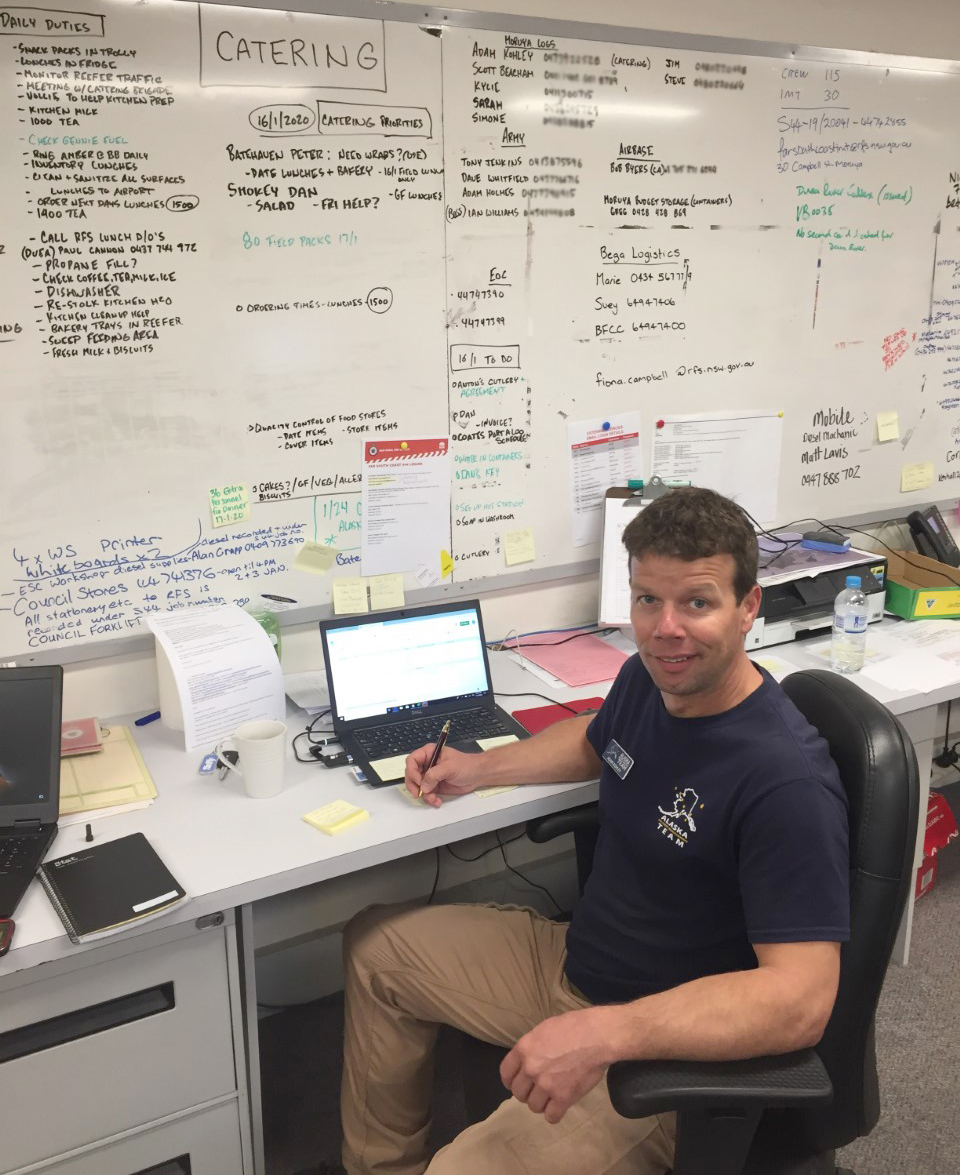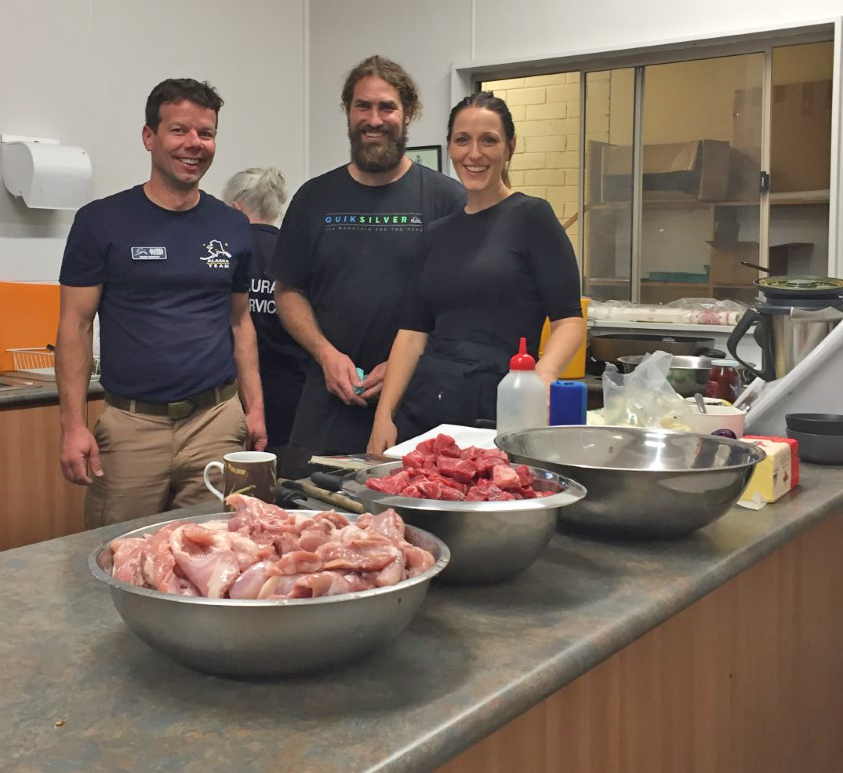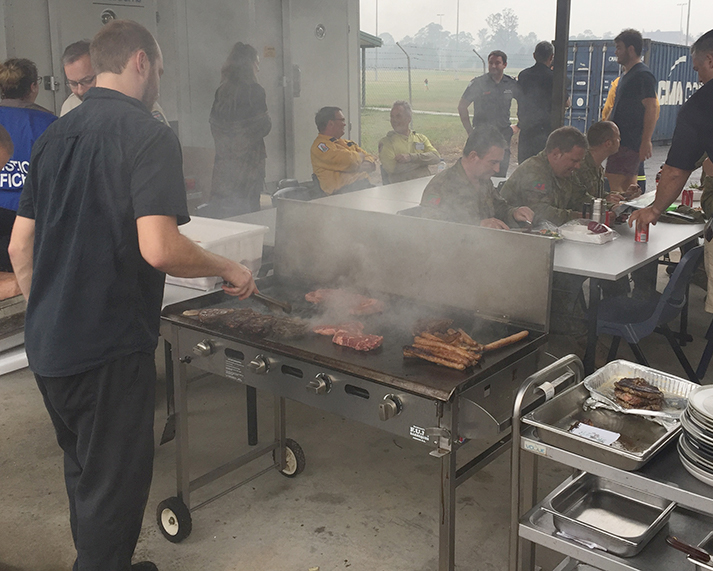You are viewing ARCHIVED content published online before January 20, 2025. Please note that this content is NOT UPDATED, and links may not work. Additionally, any previously issued diversity, equity, inclusion or gender-related guidance on this webpage should be considered rescinded. For current information, visit https://www.blm.gov/blog.
Feeding the fireys
They may have a few differences in cultures, firefighting organizations and even what they call firefighters, but aside from that, Americans, Aussies, Kiwis and Canadians are united in their effort against bushfires in Australia.
“Aside of the color of our shirts, we’re all doing the same job,” Adam Kohley said by phone from Moruya in New South Wales recently. The far south coast town is about 300 miles south of Sydney. “It’s all slightly to a lot different from what we’re used to. Everyone is adapting … Everybody is pretty cool.”
Like many other BLM AFS employees, Kohley doesn’t work during the off season, but he didn’t hesitate to sign up to help when the Australia bushfires surfaced in November. He is one of six BLM AFS employees and among about 242 U.S. federal firefighting personnel that have so far deployed to Australia as the country grapples with a deadly fire season.
“I had the capacity and experience to respond and knew I could make a difference, even if for only a few people,” Kohley said. “No question. That decision is worth it every time.”

Adam Kohley sits in front of a whiteboard he meticulously organized during his deployment to New South Wales. Kohley, who was originally deployed as a planning section chief, said he’s received a lot of comments on his organizational skills exhibited on the whiteboard.
Kohley works as a Training Specialist for BLM Alaska Fire Service and is the Planning Section Chief for one of the Type 2 Alaska Interagency Incident Management Teams. While the U.S. uses a career firefighting force to fight wildfires, Australia relied heavily upon volunteers for the past five months as bushfires burned approximately 28 million acres and killed 31 people, including eight firefighting personnel. Five months is a long time for a volunteer force, and people often had to take time off to defend their own properties.
Neither did Kohley hesitate when his group of eight Canadians and Americans were asked for someone to be a food unit leader. Although he was initially ordered as a planning section chief, known as a planning officer in Australia, upon arrival, the group was given instructions to “fill in wherever needed.”
“Of course, I volunteered for catering – to be tasked with arranging meals for firefighters,” he said.

From left to right, BLM AFS Training Specialist Adam Kohley, who is in charge of arranging meals for fireys and support personnel during his deployment to Moruya, New South Wales, is pictured with Anton and Jade Blue, incident caterers and owners of a café in nearby Bodalla.
“I’m part of giving them an opportunity, even if only a couple of times a day, when they can let go of their work and worries to enjoy a meal and a moment to themselves or to share a chat with their table mates. It’s a bright spot in the tough days that I’m happy to be a part of.”
Kohley keeps busy learning the ins and outs of Aussie jargon as well as the job making sure the firefighting personnel, or fireys as they’re called, are fed. While it’s not a position he’s held before, he’s used his logistics experience gained in Alaska to coordinate feeding between 100 and 150 fireys and the supporting workforce out of the fire center in Moruya. This involves lining up local caterers to provide food five days at a time. He’s also in charge of the cache of supplies and ensuring there’s enough porta-potties and dumpsters. Eventually, he wants to tackle organizing donations that have been rolling in by the truckloads.
“I’m super comfortable in this role,” he said. It’s given him a chance to venture outside the fire center more than his American and Canadian counterparts.
One of the unique parts of the job is meeting and interacting with local business owners impacted by the fires.
“We’re trying to cycle local restaurant owners in to cater, allowing them to recoup some of their losses over the past few weeks, which are unfortunately some of their busiest weeks of the year, typically,” he said.

He’s also learned the Aussies are very serious about their 10 a.m. and 2 p.m. tea, usually served with biscuits or sweet pastries.
While he spoke on the phone, a cacophony of screeches and screams in the background made it sound like he was standing in the middle of a school playground. Instead, he was underneath trees loaded with brightly colorful and very vocal parakeets, parrots and mockingbirds. He’s also seen kangaroos running through an open field behind the fire station, or “paddock” as it’s called in Australia.
“The birds here are crazy,” he said. They’re particularly loud in the morning. “And the large bats, well, they’re something else every evening.”
Besides the pleasant 60-80 degree weather he’s experienced while working during Australia’s summertime on the far south coast, they’re a constant reminder that he’s not in Alaska anymore.
This is some of the jargon Adam Kohley's picked up during his month-long deployment:
fireys – firefighters, not to be confused with the Muppet creatures from the movie “Labyrinth”
cooler – a refrigerator or a refrigerator truck
esky – what we commonly refer to as a cooler or insulated food and drink container
paddock – a small field
sweet as – The old English phrase “sweet as a nut” was shortened and means something is cool or really good
bloke – a well-regarded man
fortnight – two weeks
ute – truck
biscuits – cookies
occy (or octopus) strap – a bungee cord
legend – frequent compliment to call a person when they do something well
grand – used frequently and is used to explain something great
how you going? – the Aussie way of asking how’s it going
too easy –in response to just about any request, Kohley said. For example: “Hey mate, can you grab a 100 soldiers and move 27 pallets of water across the paddock?” Answer: “Too easy”
~Story by BLM Alaska Fire Service Public Affairs Specialist Beth Ipsen ([email protected]). Photos courtesy Adam Kohley, BLM AFS.
#AKinAUS #NSWRFS #AustraliaFires #USwithAUS
Related Stories
- BLM Fire Team brings Smokey Bear to Kingman’s Street of Lights
- Rural wildland firefighting partners grateful for BLM gift
- Using science to uncover mysteries of the Mesa archaeological site in Alaska
- BLM hosts fire investigation training course to strengthen wildland fire investigation capacity across Arizona and the West
- Helping Woodlands & Fighting Fire with the Dawson Project
